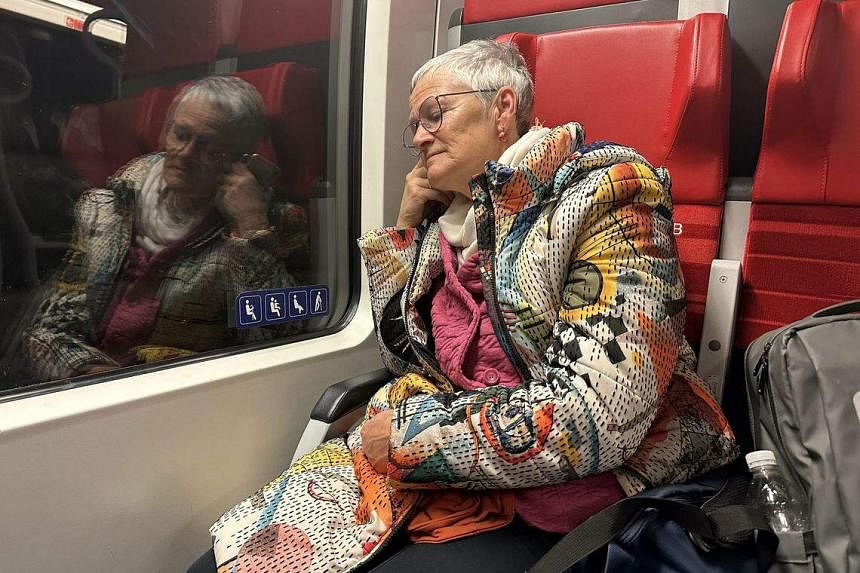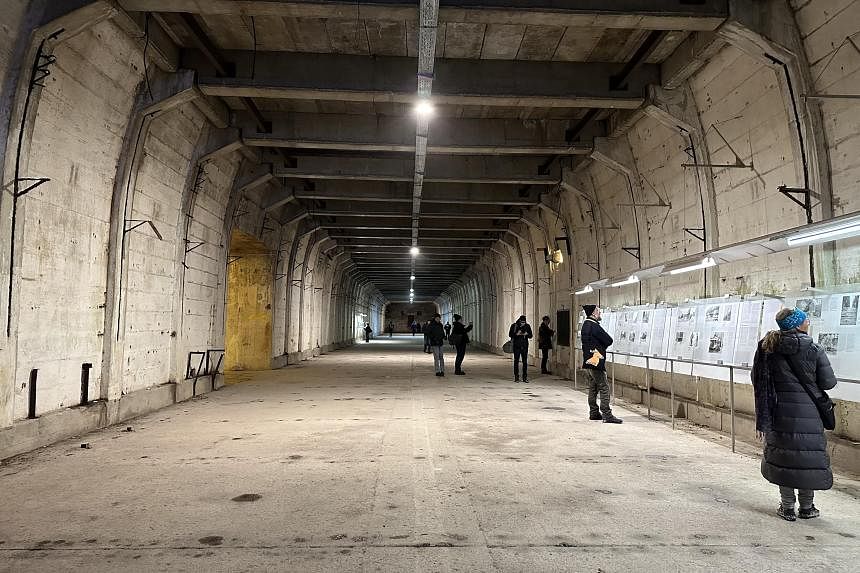SALZKAMMERGUT, Austria – There is a Singapore connection in Salzkammergut’s arts programme for its year as one of Europe’s Capitals of Culture (ECOC) in 2024.
The Regional Express, a five-part immersive audio experience, was co-created by assistant professor Ella Raidel, who teaches film-making at the School of Art, Design and Media, Nanyang Technological University.
Through The Regional Express website (regional-express.org/tour), train passengers can listen to stories about the communities along a commuter route that runs from the towns of Gmunden to Bad Aussee in the Salzkammergut region near Salzburg.
At a media preview at Gmunden train station in late January, Prof Raidel, who is Austrian, describes the project as “a new way of seeing and listening, a new form of cinema. The landscape passes by the train windows like a cinematic experience”.
One of the series’ most intriguing – and disturbing – stories comes from Ms Silvia Dinhof-Cueto, daughter of Mr Victor Cueto, a Spanish Republican who was arrested as a political prisoner and ended up in a Nazi concentration camp in Ebensee.
Today, Ebensee is a sleepily idyllic Alpine town nestled amid picturesque mountains. Neat houses are laid out just steps away from a cavernous tunnel – meant for the Nazi rocket project – built by concentration camp victims.
Ms Dinhof-Cueto, 70, is emotional about The Regional Express, which addresses a neglected aspect of Austrian history. Though her father survived the war, he remained stateless in Austria for many years, despite marrying an Austrian woman and starting a family.
“When my father was alive, no one spoke to him about his experiences. Even now, no one asks me why I have a Spanish name,” she says.

An English version of the soundtrack will go live in March and an augmented-reality element will be ready by August.
Prof Raidel tells The Straits Times that this is a living heritage project. “The main aim is not to reconstruct history in every detail, but to build a bridge between the lives of the audience now and the historical past so that they can relate to it in an intimate manner.”
She adds that for fellow creator, dramaturg and theatremaker Petra Ardai, “juxtaposing the landscape’s beauty with the horrors that unfolded there was striking”.
Dr Wolfgang Quatember, director of the Zeitgeschichte Museum Ebensee (Contemporary History Museum & Concentration Camp Memorial Ebensee), is blunt about Austria’s failure to deal with its Nazi past: “The narrative is that Austria was the first victim of the Nazi invasion. I always felt it was a lie.”
Dr Quatember, who also participated in The Regional Express, notes that it was only in the 1980s that younger historians began addressing this narrative.

More than 27,000 people were sent to the Ebensee camp and more than 8,500 people died before the camp was liberated on May 6, 1945.
The Regional Express is one of more than 200 arts projects commissioned for the ECOC, a programme founded in 1985 to celebrate the diversity of cultures in Europe.
Salzkammergut (“salt chamber estate” in German), a mountainous region in the heart of Austria, is the first rural area to be chosen.
The projects are an eclectic mix of the experimental and the classic.
Plateau Blo, for example, comprises four floating structures on Lake Traunsee including a sauna where visitors can sign up for sessions.

More traditional programmes throughout the year include the grand reopening of the restored Franz Lehar Museum in May, and a series of concerts and exhibitions celebrating composer Anton Bruckner’s 200th birth anniversary.
In Salzkammergut’s most famous resort town Bad Ischl, a banner proclaims: Culture is the new salt.
The motto is especially resonant as salt, a tangible commodity, has been valued and traded in the region for some 7,000 years.
Salt was the main source of wealth for the Habsburg monarchy, which controlled Salzkammergut and which ruled over a broad swathe of Europe in the 18th and 19th centuries.
But culture is what the 23 municipalities in this region are counting on to reboot its economy and communities in 2024. Like many rural communities around the world, the region’s economic development has slowed since its glory days as the resort getaway du jour of European royalty.
At a press conference at Bad Ischl’s Trinkhalle building, its mayor Ines Schiller characterises the ECOC appointment as a way for Salzkammergut to “look beyond the borders of our tiny region. We will show that 23 little villages can make a name for themselves”.
Over the years, the ECOC programme has become a means of revitalising cities by leveraging the power of arts and culture to build communal pride, boost tourism and create jobs.
Studies have found that areas that have hosted ECOC events experienced an average of 3.2 to 8 per cent increase in tourism.
Politicians and bureaucrats are evidently hoping Salzkammergut’s rich culture will be the key to unlocking new markets.
Mr Leopold Schilcher, mayor of the town of Bad Goisern, tells The Straits Times that the town attracts some 400,000 overnight visits annually. “The majority of our visitors come from Europe, but we want to reach out to Asia.”
Tourist authorities have introduced a KulturCard (€49, or about S$71), which offers discounts to concerts and exhibitions as well as ECOC events.
Some €30 million in funding has been channelled into ECOC programming, planning for which began in 2021 when veteran curator Elisabeth Schweeger was appointed artistic director.
While technocrats are counting on economic payoffs, the artists creating the programmes are using the funding as a springboard to build a legacy beyond 2024.
Gmundner Keramik (Gmundner Ceramics) in Gmunden, for example, which dates back to 1492, is famed for its green flamed pattern.
But the skill was on the verge of disappearing, with only four women skilled in painting the pattern, says Ms Genoveva Rueckert, curator for contemporary art with Oberosterreich Landes-Kultur GmbH (Upper Austria State Culture).

Austrian entrepreneur and former racecar driver Markus Friesacher bought the company in 2018 and decided to preserve its heritage.
The “flaming of pottery” has since been designated an intangible cultural heritage by Unesco in 2021 and apprenticeship programmes have been introduced to keep the skills alive.
The year of culture comes in time for the company to showcase its refreshed purpose. Gmundner Keramik is organising group exhibitions that bridge the gap between high art and craftsmanship, and showing ceramics made by Namibia’s San people, where the company runs a social enterprise to teach poor communities ceramic-making.
There is a similar pride at Hand.Werk.Haus (Hand.Craft.House) in Bad Goisern. On a tour of the facilities – which include a shop, workrooms and a multipurpose space – the non-profit collective’s facilitator Barbara Kern says: “We wish to make craftsmanship and manual skills visible to the world.”

One of its highlights is the PerlMUT exhibition in May, which will spin off from the folk tradition of the pearl bonnet.
The traditional headgear dates back to the 18th century and is hand-embroidered with gold, beads and pearls. Women have kept this tradition alive in amateur groups across Austria, and the group in Bad Goisern is organising a parade for the event.
Such community outreach is integral to what the Hand.Werk.Haus is doing, says Ms Kern. “We want to connect to the population and we want the population to connect to their culture and heritage.”

Across the street from Hand.Werk.Haus is the Salzkammergut Craft Art Lab (Scala), developed with ECOC funding. An old Roman Catholic school building has been repurposed to house artist residencies and workshops.
Scala artist and curator Michael Viorner notes that there are “cultural differences between artists and craftspeople”.
“It’s not easy for them to talk to each other,” he says. “There’s a huge difference even though they work with the same materials.”

Scala offers a space for dialogue, not just between artists and craftsmen, but also with the wider community, with its open-house sessions and workshops which have attracted thousands of locals over the past months.
This is why he welcomes the ECOC nomination. “What the ECOC allows us to do is establish connections.”
Ms Kern agrees. “We see it as a big opportunity, this exchange and the coming together of locals, Europeans and overseas visitors that is now possible here in this rural area.”
Mr Viorner is pragmatic about the more mercenary aspects of the year of culture, pointing out: “Tourism keeps it alive. Without tourism, we wouldn’t exist.”
Prof Raidel sums up the dilemma which Salzkammergut is hoping to ameliorate with the ECOC, noting that the closed mountain region of Salzkammergut needs to open up to new influences without losing its heritage and culture: “Art, the power of imagination, can open dialogues and show ways to envision more inclusive and sustainable futures.”
While she is ambivalent about the impact of mass tourism on the region, having made a film on its negative impacts on the tiny Unesco heritage site of Hallstatt, she nonetheless concludes with a message to Singaporeans: “Come to the Salzkammergut and take the train from Gmunden to Bad Aussee. Prepare your headphones and listen to our journey.”
She adds: “Share your experience with us. We would love to hear from you.”
- The Regional Express can be found on Facebook and Instagram at the handle @regionalexpress2024
- The writer was in Austria at the invitation of the Austrian National Tourist Office.


